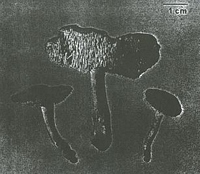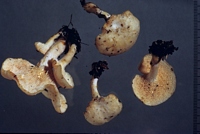|
 Hydnum crocidens Hydnum crocidens
SynonymsDentinum crocidens
BiostatusPresent in region
Images (click to enlarge) | 
Owner: Herb. PDD |
Article: McNabb, R.F.R. (1971). Some new and revised taxa of New Zealand Basidiomycetes (Fungi). New Zealand Journal of Botany 9(2): 355-370 (http://www.rsnz.org/publish/abstracts.php).
Description: Fructifications fleshy, stiptate and pileate. Pileus 1-4 cm diam., dry, applanate and slightly centrally depressed, finely felted when young, centrally glabrous with felted margins at maturity, white, pallid creamy white, or pallid cream, occasionally with faint shell pink tints, stained with ochraceous or rusty brown patches when overmature, drying pallid yellow, yellow-brown, orange-brown, or sometimes dark reddish brown: margins involute when young, thin, entire, often undulate. Hymenial surface ± concolorous with pileus, drying orange-brown, sterile margin absent, spines non-decurrent but reaching stipe, to 4 mm long, crowded, subulate, pallid creamy white, often with faint shell pink tints. Stipe central, occasionally excentric or lateral, 1.3-3 cm long, ± equal, 2-4 mm diam., solid, finely felted, concolorous with pileus, drying same colours as pileus; flesh concolorous with exterior. Context fleshy, to 1 mm thick, pallid creamy white, azonate, monomitic. Hyphae thin-walled, inflating, 4-12.5µm diam., readily collapsing, clamp connections present; superficial hyphae in young fructifications similar but of smaller and more even diam., typically aggregated into tufts, 3-6 µm diam. Basidia irregularly subclavate, 35-52 x 5.5-8.5 µm, 4-(5)-spored, sterigmata to 5 µm long; cystidia absent. Spores globose, subglobose, or occasionally broadly elliptical, hyaline, thin-walled, readily collapsing, 6.8-8.2-(9) x 6-7.5 µm, smooth.
Habitat: Solitary or gregarious under native trees and shrubs
Distribution: TYPE LOCALITY: Port Phillip, Victoria, Australia.
Notes: Maas Geesteranus (1964) considered Hydnum crocidens inseparable from the H. repandum complex, but because of its extreme variability in habit, was unable to decide on its status within that complex. On the basis of the specimens examined, I am reluctant to reduce the species to synonymy under H. repandum. Although it is an extremely variable species as found in New Zealand, three well defined forms worthy of variental rank can be distinguished. In microscopical characters, the above description of the type variety agrees closely with that of Maas Geesteranus (1964), except that in mature frutifications, spores are primarily subglobose to globose and are only occasionally broadly elliptical. Maas Geesteranus considered that globose spores were immature even though they were in the majority. However, in ephemeral characters such as colour of pileus and spines, and texture of pileus surface, the present description differs from those of both Cunningham (1958) and Maas Geesteranus.
Hydnum crocidens var. crocidens may be distinguished by the pallid, predominantly centrally stipitate fructifications, and the non-decurrent spines. It favours habitats where Leptospermum is present.
|